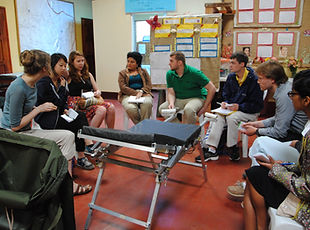

Formerly known as the Maternal Health Team
Gynecological Health in the Developing World
Despite being highly preventable with regular screening tests to identify pre-cancerous conditions [1], cervical cancer is the leading cause of death from cancer among women in developing countries, where it causes almost 200,000 deaths each year [2]. Additionally, adolescent pregnancies are common in the developing world, but these types of pregnancies present significant health risks; the risk of maternal death is four times higher among adolescents younger than 16 years than among women in their twenties [3].
Nicaragua has the highest mortality from cervical cancer [4] and highest teenage pregnancy rate [5] in Latin America. Regular gynecological examinations are necessary to screen for pre-cancerous conditions as well as to monitor pregnancies, especially in adolescents at high-risk for complications [6]. However, gynecological exams are difficult to conduct in rural mobile clinics within Nicaragua because of a lack of portable and affordable equipment. Clinicians travel upwards of six hours to reach rural communities and are only able to bring supplies they can physically carry. As a result, many exams are conducted on household beds or tables in poor lighting conditions, not only making the exams unsterile and uncomfortable for both the staff and patient, but also limiting the success and efficiency of identifying health-risks.
Mission Statement
Develop a method that enables local clinicians to conduct more effective and frequent women’s examinations in mobile health settings.
Team History
M-HEAL’s Project MESA began with a needs assessment trip to Nicaragua in August 2010. By visiting several clinics focused on maternal health and education, the students found that limited transportation to clinics and a lack of portable equipment are two challenges rural women face in receiving gynecological examinations. Following their trip, the team designed an alpha prototype of a portable gynecological exam table that folds into a large backpack. Our team has since developed two iterations of a portable gynecological examination table that fits into a custom-built backpack for easy transportation to rural communities. Our main design criteria are that the table is safe to use and affordable, enables appropriate and comfortable patient positioning, and can be easily transported long distances. The design utilizes materials locally-available in rural communities in Nicaragua, namely aluminum stock, sheet metal, and PVC, and is built using low-cost manufacturing techniques to enable simple repairs.
Current Work
Under the guidance of faculty and corporate mentors and advisors, our team is developing two new iterations of our design, focusing on compactness, portability, and comfort. Additionally, we are working with global health experts to develop business models to feasibly scale our project to serve more communities, both within and outside of Nicaragua. We hope our work with diverse medical stakeholders in Nicaragua, ranging from large regional hospitals to small private-run clinics, will enable us to develop an innovative, sustainable design that can be successfully implemented and used by global communities.
Collaborations & Acknowledgements
Nicaraguan Partners
-
Casa Materna, Mary Ann Jackman | Matagalpa
-
Estelí Regional Hospital | Estelí
-
Foundation for International Medical Relief of Children (FIMRC) | Limón
-
Sacuanjoche Women’s Group | Matagalpa
-
Santa Lastenia Health Clinic | Matagalpa
-
Ministry of Health Public Health Post | Las Salinas
Advisors & Mentors
-
Michael Deininger, PhD Pre-Candidate in Design Science | Technical Advisor
-
Dr. Frank Anderson, OBGYN | Clinical Advisor
-
Dr. Kathleen Sienko, ME and BME Professor | M-HEAL Advisor
-
Dr. Aileen Huang-Saad, BME Professor | M-HEAL Advisor
-
Dr. Clive D’Souza, IOE Ergonomics Professor
-
Dr. John Marshall, Director of MDes Integrative Design Program
-
MDes 2015 Cohort: Manasi Agarwal, Aditi Bidkar, Kuan-Ting Ho, Ji Youn Shin, Elizabeth Vander Veen, Kai Yu
Sources
-
Cervical Cancer (2015). Centers for Disease Control and Prevention. http://www.cdc.gov/cancer/dcpc/resources/features/cervicalcancer/.
-
Sherris, J., Herdman, C., & Elias, C. (2001). Cervical cancer in the developing world. Western Journal of Medicine, 175(4), 231–233. http://www.ncbi.nlm.nih.gov/pmc/articles/PMC1071564/.
-
Adolescent pregnancy. World Health Organization: Maternal health. http://www.who.int/maternal_child_adolescent/topics/maternal/adolescent_pregnancy/en/.
-
Creel, L. (2000). Cervical cancer is major health problem in Latin America. Population Reference Bureau. http://www.prb.org/Publications/Articles/2000/CervicalCancerIsMajorHealthProbleminLatinAmerica.aspx.
-
Nascimento, M.G. (2015). Nicaragua has the region’s highest teen pregnancy rate. Many moms are OK with it. Global Post. http://www.globalpost.com/article/6554041/2015/05/19/nicaragua-teen-pregnancy.
-
Pelvic exam for women. WebMD. http://www.webmd.com/women/guide/pelvic-examination.
Project MESA: Making Examinations Safe and Accessible
Contact: mheal-nica-leads@umich.edu


